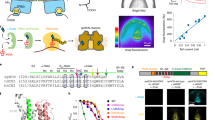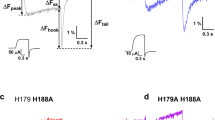Abstract
In a voltage-dependent sodium channel, the activation of voltage sensors upon depolarization leads to the opening of the pore gates. To elucidate the principles underlying this conformational coupling, we investigated a putative gating interface in domain III of the sodium channel using voltage-clamp fluorimetry and tryptophan-scanning mutagenesis. Most mutations have similar energetic effects on voltage-sensor activation and pore opening. However, several mutations stabilized the activated voltage sensor while concurrently destabilizing the open pore. When mapped onto a homology model of the sodium channel, most localized to hinge regions of the gating interface. Our analysis shows that these residues are involved in energetic coupling of the voltage sensor to the pore when both are in resting and when both are in activated conformations, supporting the notion that electromechanical coupling in a voltage-dependent ion channel involves the movement of rigid segments connected by elastic hinges.
This is a preview of subscription content, access via your institution
Access options
Subscribe to this journal
Receive 12 print issues and online access
$189.00 per year
only $15.75 per issue
Buy this article
- Purchase on Springer Link
- Instant access to full article PDF
Prices may be subject to local taxes which are calculated during checkout







Similar content being viewed by others
References
Noda, M. et al. Primary structure of Electrophorus electricus sodium channel deduced from cDNA sequence. Nature 312, 121–127 (1984).
Papazian, D.M., Schwarz, T.L., Tempel, B.L., Jan, Y.N. & Jan, L.Y. Cloning of genomic and complementary DNA from Shaker, a putative potassium channel gene from Drosophila. Science 237, 749–753 (1987).
Tempel, B.L., Papazian, D.M., Schwarz, T.L., Jan, Y.N. & Jan, L.Y. Sequence of a probable potassium channel component encoded at Shaker locus of Drosophila. Science 237, 770–775 (1987).
Yang, N., George, A.L. Jr. & Horn, R. Molecular basis of charge movement in voltage-gated sodium channels. Neuron 16, 113–122 (1996).
Perozo, E., Cortes, D.M. & Cuello, L.G. Structural rearrangements underlying K+-channel activation gating. Science 285, 73–78 (1999).
Armstrong, C.M. & Bezanilla, F. Currents related to movement of the gating particles of the sodium channels. Nature 242, 459–461 (1973).
Glauner, K.S., Mannuzzu, L.M., Gandhi, C.S. & Isacoff, E.Y. Spectroscopic mapping of voltage sensor movement in the Shaker potassium channel. Nature 402, 813–817 (1999).
Cha, A., Snyder, G.E., Selvin, P.R. & Bezanilla, F. Atomic scale movement of the voltage-sensing region in a potassium channel measured via spectroscopy. Nature 402, 809–813 (1999).
del Camino, D., Holmgren, M., Liu, Y. & Yellen, G. Blocker protection in the pore of a voltage-gated K+ channel and its structural implications. Nature 403, 321–325 (2000).
Holmgren, M., Smith, P.L. & Yellen, G. Trapping of organic blockers by closing of voltage-dependent K+ channels: evidence for a trap door mechanism of activation gating. J. Gen. Physiol. 109, 527–535 (1997).
Horn, R. Conversation between voltage sensors and gates of ion channels. Biochemistry 39, 15653–15658 (2000).
Stühmer, W. et al. Structural parts involved in activation and inactivation of the sodium channel. Nature 339, 597–603 (1989).
Strong, M., Chandy, K.G. & Gutman, G.A. Molecular evolution of voltage-sensitive ion channel genes: on the origins of electrical excitability. Mol. Biol. Evol. 10, 221–242 (1993).
Long, S.B., Campbell, E.B. & Mackinnon, R. Crystal structure of a mammalian voltage-dependent Shaker family K+ channel. Science 309, 897–903 (2005).
Long, S.B., Tao, X., Campbell, E.B. & Mackinnon, R. Atomic structure of a voltage-dependent K+ channel in a lipid membrane-like environment. Nature 450, 376–382 (2007).
Smith-Maxwell, C.J., Ledwell, J.L. & Aldrich, R.W. Uncharged S4 residues and cooperativity in voltage-dependent potassium channel activation. J. Gen. Physiol. 111, 421–439 (1998).
Lu, Z., Klem, A.M. & Ramu, Y. Coupling between voltage sensors and activation gate in voltage-gated K+ channels. J. Gen. Physiol. 120, 663–676 (2002).
Hong, K.H. & Miller, C. The lipid-protein interface of a Shaker K+ channel. J. Gen. Physiol. 115, 51–58 (2000).
Lee, S.Y., Banerjee, A. & Mackinnon, R. Two separate interfaces between the voltage sensor and pore are required for the function of voltage-dependent K+ channels. PLoS Biol. 7, e47 (2009).
Soler-Llavina, G.J., Chang, T.H. & Swartz, K.J. Functional interactions at the interface between voltage-sensing and pore domains in the Shaker Kv channel. Neuron 52, 623–634 (2006).
Labro, A.J. et al. Kv channel gating requires a compatible S4–S5 linker and bottom part of S6, constrained by non-interacting residues. J. Gen. Physiol. 132, 667–680 (2008).
Bosmans, F., Martin-Eauclaire, M.F. & Swartz, K.J. Deconstructing voltage sensor function and pharmacology in sodium channels. Nature 456, 202–208 (2008).
Li-Smerin, Y., Hackos, D.H. & Swartz, K.J. α-helical structural elements within the voltage-sensing domains of a K+ channel. J. Gen. Physiol. 115, 33–50 (2000).
Perozo, E. Structure and packing orientation of transmembrane segments in voltage-dependent channels. Lessons from perturbation analysis. J. Gen. Physiol. 115, 29–32 (2000).
Monks, S.A., Needleman, D.J. & Miller, C. Helical structure and packing orientation of the S2 segment in the Shaker K+ channel. J. Gen. Physiol. 113, 415–423 (1999).
Chanda, B. & Bezanilla, F. Tracking voltage-dependent conformational changes in skeletal muscle sodium channel during activation. J. Gen. Physiol. 120, 629–645 (2002).
Yarov-Yarovoy, V. et al. Molecular determinants of voltage-dependent gating and binding of pore-blocking drugs in transmembrane segment IIIS6 of the Na+ channel α subunit. J. Biol. Chem. 276, 20–27 (2001).
West, J.W. et al. A cluster of hydrophobic amino acid residues required for fast Na+-channel inactivation. Proc. Natl. Acad. Sci. USA 89, 10910–10914 (1992).
Ahern, C.A. & Horn, R. Focused electric field across the voltage sensor of potassium channels. Neuron 48, 25–29 (2005).
Chanda, B. & Bezanilla, F. A common pathway for charge transport through voltage-sensing domains. Neuron 57, 345–351 (2008).
Tristani-Firouzi, M., Chen, J. & Sanguinetti, M.C. Interactions between S4–S5 linker and S6 transmembrane domain modulate gating of HERG K+ channels. J. Biol. Chem. 277, 18994–19000 (2002).
Ma, J.C. & Dougherty, D.A. The cation-π interaction. Chem. Rev. 97, 1303–1324 (1997).
Ryzhov, V., Dunbar, R.C., Cerda, B. & Wesdemiotis, C. Cation-π effects in the complexation of Na+ and K+ with Phe, Tyr, and Trp in the gas phase. J. Am. Soc. Mass Spectrom. 11, 1037–1046 (2000).
Mecozzi, S., West, A.P. Jr. & Dougherty, D.A. Cation-π interactions in aromatics of biological and medicinal interest: electrostatic potential surfaces as a useful qualitative guide. Proc. Natl. Acad. Sci. USA 93, 10566–10571 (1996).
Doyle, D.A. et al. The structure of the potassium channel: molecular basis of K+ conduction and selectivity. Science 280, 69–77 (1998).
Hackos, D.H., Chang, T.H. & Swartz, K.J. Scanning the intracellular S6 activation gate in the shaker K+ channel. J. Gen. Physiol. 119, 521–532 (2002).
Ding, S. & Horn, R. Effect of S6 tail mutations on charge movement in Shaker potassium channels. Biophys. J. 84, 295–305 (2003).
Yifrach, O. & Mackinnon, R. Energetics of pore opening in a voltage-gated K+ channel. Cell 111, 231–239 (2002).
Wynia-Smith, S.L., Gillian-Daniel, A.L., Satyshur, K.A. & Robertson, G.A. hERG gating microdomains defined by S6 mutagenesis and molecular modeling. J. Gen. Physiol. 132, 507–520 (2008).
Ledwell, J.L. & Aldrich, R.W. Mutations in the S4 region isolate the final voltage-dependent cooperative step in potassium channel activation. J. Gen. Physiol. 113, 389–414 (1999).
Brooks, B. & Karplus, M. Harmonic dynamics of proteins: normal modes and fluctuations in bovine pancreatic trypsin inhibitor. Proc. Natl. Acad. Sci. USA 80, 6571–6575 (1983).
McCammon, J.A., Gelin, B.R., Karplus, M. & Wolynes, P.G. The hinge-bending mode in lysozyme. Nature 262, 325–326 (1976).
McCammon, J.A., Gelin, B.R. & Karplus, M. Dynamics of folded proteins. Nature 267, 585–590 (1977).
Oi, V.T. et al. Correlation between segmental flexibility and effector function of antibodies. Nature 307, 136–140 (1984).
Mao, B., Pear, M.R., McCammon, J.A. & Quiocho, F.A. Hinge-bending in L-arabinose-binding protein. The “Venus's-flytrap” model. J. Biol. Chem. 257, 1131–1133 (1982).
Colonna-Cesari, F. et al. Interdomain motion in liver alcohol dehydrogenase. Structural and energetic analysis of the hinge bending mode. J. Biol. Chem. 261, 15273–15280 (1986).
Auerbach, A. Gating of acetylcholine receptor channels: brownian motion across a broad transition state. Proc. Natl. Acad. Sci. USA 102, 1408–1412 (2005).
Mitra, A., Tascione, R., Auerbach, A. & Licht, S. Plasticity of acetylcholine receptor gating motions via rate-energy relationships. Biophys. J. 89, 3071–3078 (2005).
Purohit, P., Mitra, A. & Auerbach, A. A stepwise mechanism for acetylcholine receptor channel gating. Nature 446, 930–933 (2007).
Muroi, Y. & Chanda, B. Local anesthetics disrupt energetic coupling between the voltage-sensing segments of a sodium channel. J. Gen. Physiol. 133, 1–15 (2009).
Thompson, J.D., Higgins, D.G. & Gibson, T.J. CLUSTAL W: improving the sensitivity of progressive multiple sequence alignment through sequence weighting, position-specific gap penalties and weight matrix choice. Nucleic Acids Res. 22, 4673–4680 (1994).
Sali, A. & Blundell, T.L. Comparative protein modelling by satisfaction of spatial restraints. J. Mol. Biol. 234, 779–815 (1993).
Zhorov, B.S. Vector method for calculating derivatives of energy of atom-atom interactions of complex molecules according to generalized coordinates. J. Struct. Chem. 22, 4–8 (1981).
Acknowledgements
This project was supported by funds from the US National Institutes of Health (GM084140-01), the American Heart Association Scientist Development Award (0535214N) and the Shaw Scientist award to B.C. We thank M. Goldschen for help with preparing Supplementary Figure 3, K. Schuldt for excellent technical assistance and the members of the Chanda laboratory for their comments and discussions.
Author information
Authors and Affiliations
Contributions
Y.M. and M.A-.M. contributed equally to this work; Y.M. and M.A.-M. performed all the experiments and analyzed the data; S.C. created the structural model; S.C. and B.C. generated the coupling models; Y.M., M.A.-M. and B.C. wrote the paper.
Corresponding author
Ethics declarations
Competing interests
The authors declare no competing financial interests.
Supplementary information
Supplementary Text and Figures
Supplementary Figures 1–4, Supplementary Tables 1 and 2, and Supplementary Methods (PDF 2066 kb)
Rights and permissions
About this article
Cite this article
Muroi, Y., Arcisio-Miranda, M., Chowdhury, S. et al. Molecular determinants of coupling between the domain III voltage sensor and pore of a sodium channel. Nat Struct Mol Biol 17, 230–237 (2010). https://doi.org/10.1038/nsmb.1749
Received:
Accepted:
Published:
Issue Date:
DOI: https://doi.org/10.1038/nsmb.1749
This article is cited by
-
Gating interaction maps reveal a noncanonical electromechanical coupling mode in the Shaker K+ channel
Nature Structural & Molecular Biology (2018)
-
Structural modelling and mutant cycle analysis predict pharmacoresponsiveness of a Nav1.7 mutant channel
Nature Communications (2012)
-
Voltage-gated sodium channel-associated proteins and alternative mechanisms of inactivation and block
Cellular and Molecular Life Sciences (2012)



